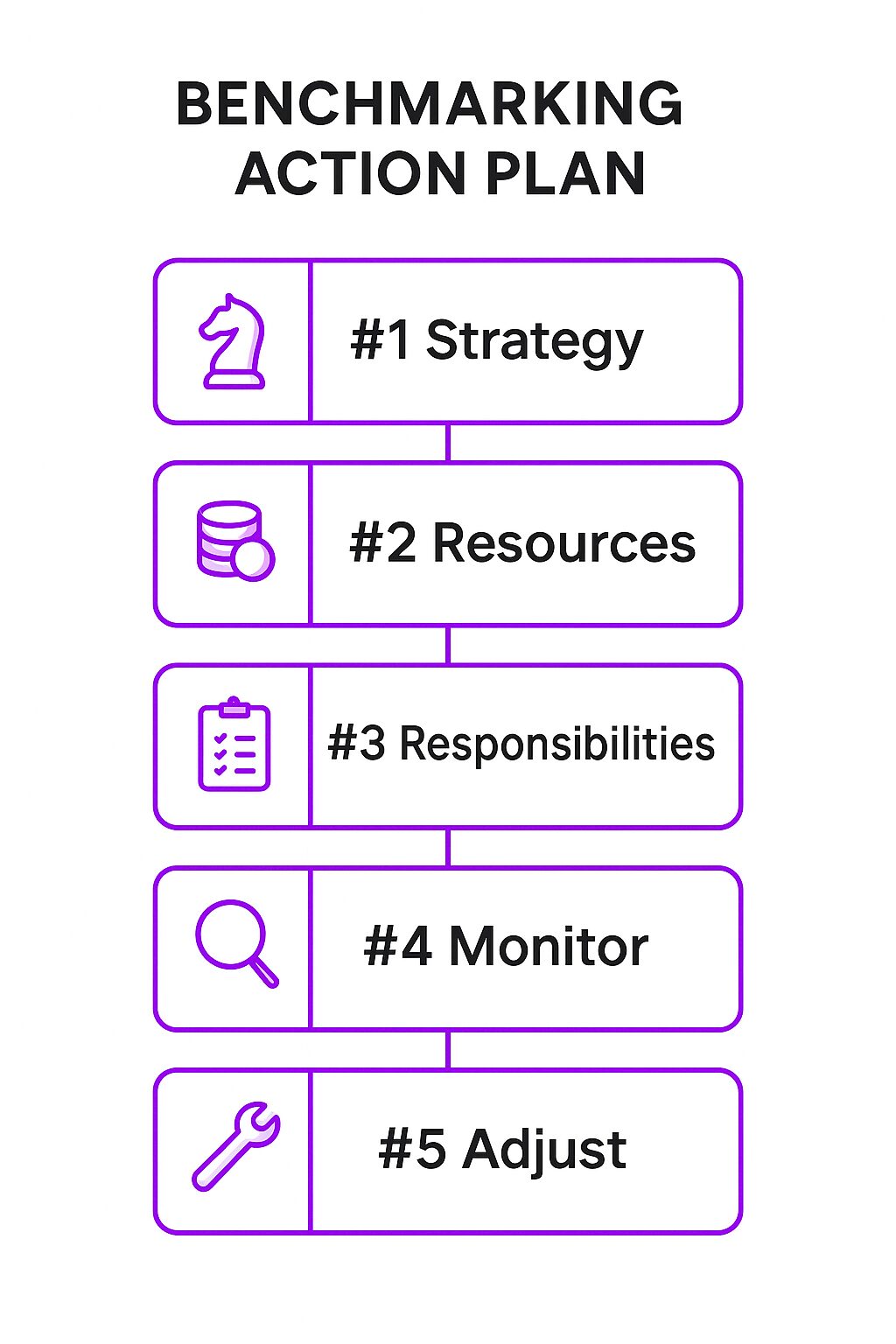Benchmarking is a method businesses use to measure their performance against competitors or industry standards. It helps companies benchmark determine specific areas to identify gaps, improve processes, and stay competitive. Whether you’re looking at internal data or comparing with industry leaders, benchmarking provides a clear roadmap for improvement.
What is Benchmarking?
Benchmarking is a systematic process of measuring and comparing an organization’s performance, processes, and practices against those of other organizations, either within the same industry or across different industries. The goal of benchmarking is to identify gaps in performance, uncover opportunities for improvement, and gain a competitive edge. By collecting and analyzing benchmarking data, businesses can identify best practices and implement changes to enhance business performance, customer satisfaction, and overall competitiveness. This continuous process helps organizations stay ahead in a dynamic market, ensuring they meet and exceed industry standards.
Understanding Benchmarking
Benchmarking is more than just comparing numbers. It involves a structured approach to analyzing performance, understanding best practices, and implementing changes to enhance efficiency. Businesses use it to assess everything from customer service to operational costs, productivity, and market positioning.
There are different types of benchmarking, each serving a specific purpose. Some companies analyze their own historical data (internal benchmarking), while others compare themselves to direct competitors (competitive benchmarking). Some businesses even look outside their industry to find new ways to innovate (functional benchmarking).
The Benchmarking Process
Identifying What to Measure
The first step in benchmarking is deciding what to measure. This could be customer satisfaction, production speed, employee productivity, or financial performance. The key is to choose metrics that align with business goals.
Plan and Identify Gaps
To start the benchmarking process, it’s essential to plan and identify gaps in performance. This involves:
-
Defining the Scope: Clearly outline the objectives and scope of the benchmarking project.
-
Identifying Key Performance Indicators (KPIs): Select the KPIs that align with your business goals and will provide meaningful insights.
-
Collecting Data: Gather data on current performance from reliable sources.
-
Analyzing Data: Examine the data to identify performance gaps and areas needing improvement.
-
Identifying Best Practices: Look for best practices within your industry or from other sectors that can be adapted to your organization.
By planning and identifying gaps, organizations can focus their benchmarking efforts on areas that will have the greatest impact on business performance, ensuring a strategic approach to improvement.
Collecting Data
Once the metrics are set, businesses gather relevant data. This can come from internal sources like reports, surveys, or performance analytics. External data may come from industry reports, competitor analysis, or third-party research firms.
Comparing and Analyzing
After data collection, companies compare their performance against the selected benchmarks. The goal is to identify areas where they fall short and understand what top performers are doing differently.
Develop and Implement an Action Plan
Once gaps in performance have been identified, it’s essential to develop and implement an action plan to address them. This involves:
-
Developing a Strategy: Create a comprehensive strategy for improvement based on benchmarking insights.
-
Identifying Resources and Budget: Determine the resources and budget required for implementation.
-
Assigning Responsibilities and Timelines: Allocate tasks and set realistic timelines for implementation.
-
Monitoring and Evaluating Progress: Regularly track progress and evaluate the effectiveness of the implemented changes.
-
Making Adjustments: Be prepared to make necessary adjustments to the plan based on ongoing monitoring and feedback.
By developing and implementing an action plan, organizations can ensure that the insights gained from benchmarking are translated into tangible improvements in business performance, driving continuous growth and success.
Implementing Changes
Benchmarking is useless without action. Businesses take insights from the analysis and develop strategies for improvement. This might involve adjusting workflows, adopting new technologies, or training employees.
Continuous Monitoring
Benchmarking isn’t a one-time task. It requires ongoing monitoring to track progress and ensure improvements are sustainable.
Why Benchmarking Matters
Businesses operate in a competitive environment. Without benchmarking, it’s easy to fall behind without realizing it. By consistently measuring performance, companies can identify weaknesses before they become major problems.
It also helps businesses set realistic goals. Instead of aiming for abstract targets, they can set data-driven objectives based on industry standards.
Benefits of Benchmarking
-
Identifies Strengths and Weaknesses: Businesses can pinpoint what’s working and what needs improvement.
-
Improves Efficiency: By studying top performers, companies learn how to streamline operations.
-
Encourages Innovation: Exposure to industry best practices can inspire new ideas.
-
Enhances Decision-Making: Leaders make informed choices backed by data.
-
Increases Competitiveness: Staying ahead requires constant improvement, and benchmarking provides a roadmap for that.
Challenges of Benchmarking
While benchmarking offers numerous benefits, it also has limitations.
-
Data Accuracy: Finding reliable, comparable data can be difficult.
-
Cost and Resources: Gathering and analyzing data takes time and money.
-
Resistance to Change: Employees may be reluctant to adopt new practices.
-
Over-Reliance on Benchmarks: Businesses should use benchmarking as a guide, not a rigid rule.
Different Types of Benchmarking
Internal Benchmarking
Comparing different departments or time periods within the same company. For example, a company might analyze last year’s sales performance against this year’s to gauge progress.
Competitive Benchmarking
Comparing performance against direct competitors. A retail store may analyze how its customer service scores compare to those of a rival chain.
Functional Benchmarking
Looking at companies outside the industry to adopt best practices. A hospital might study airline customer service to improve patient experience.
Process Benchmarking
Focusing on workflow efficiency. A manufacturer may compare its supply chain process with top logistics firms.
Performance Benchmarking
Tracking key performance indicators like revenue growth, profit margins, or customer retention rates.
Strategic Benchmarking
Strategic benchmarking, or strategic benchmark, involves examining long-term industry trends to guide future planning. Companies may analyze how emerging technologies impact competitors and adjust their strategies accordingly.
Project Management and Benchmarking
Project management and benchmarking are closely related. Benchmarking can be used to improve project management by:
-
Identifying Best Practices: Discover and adopt best practices in project management from leading organizations.
-
Comparing Project Performance: Measure your project performance against industry benchmarks to identify areas for improvement.
-
Improving Processes: Use benchmarking insights to refine project management processes, enhancing efficiency and effectiveness.
-
Developing Strategies: Formulate strategies to improve project outcomes based on benchmarking data.
By integrating benchmarking into project management, organizations can improve project outcomes, reduce costs, and enhance customer satisfaction. This approach ensures that projects are managed more effectively, leading to better results and higher levels of client satisfaction.
Real-World Examples of Benchmarking
-
Retail: A clothing brand studies competitors’ online shopping experience to enhance its own e-commerce platform.
-
Manufacturing: A car manufacturer compares production times and defect rates with industry leaders.
-
Healthcare: A hospital benchmarks patient wait times against national standards.
-
Finance: A bank assesses its loan approval speed against industry norms to improve service efficiency.
Best Practices for Effective Benchmarking
-
Set Clear Objectives: Define what you want to achieve.
-
Use Reliable Data: Ensure accuracy and relevance.
-
Choose the Right Type: Pick benchmarking methods that align with your goals.
-
Act on Insights: Implement findings to drive improvements.
-
Monitor Progress: Regularly review performance to stay on track.
Benchmarking FAQ
Q: What is the difference between benchmarking and performance measurement? A: Benchmarking involves comparing performance against external standards, while performance measurement involves tracking performance against internal goals and targets.
Q: What are the different types of benchmarking? A: There are several types of benchmarking, including internal benchmarking, competitive benchmarking, external benchmarking, technical benchmarking, and strategic benchmarking.
Q: How often should benchmarking be done? A: Benchmarking should be done regularly, ideally on an ongoing basis, to ensure that organizations stay competitive and continue to improve.
Q: What are the benefits of benchmarking? A: The benefits of benchmarking include improved business performance, increased customer satisfaction, and a competitive edge.
Q: How can benchmarking be used to identify performance gaps? A: Benchmarking can be used to identify performance gaps by comparing performance against external standards and identifying areas for improvement.
Q: What is the role of data collection in benchmarking? A: Data collection is a critical component of benchmarking, as it provides the insights needed to identify areas for improvement and develop strategies for improvement.
Q: How can benchmarking be used to improve customer satisfaction? A: Benchmarking can be used to improve customer satisfaction by identifying best practices in customer service and comparing performance against industry benchmarks.
Q: What is the relationship between benchmarking and key performance indicators (KPIs)? A: Benchmarking and KPIs are closely related, as benchmarking involves comparing performance against external standards, while KPIs involve tracking performance against internal goals and targets.
Q: How can benchmarking be used to improve business performance? A: Benchmarking can be used to improve business performance by identifying areas for improvement, developing strategies for improvement, and monitoring progress.
Q: What is the role of practice benchmarking in improving business performance? A: Practice benchmarking involves identifying best practices in business processes and comparing performance against industry benchmarks. It can be used to improve business performance by identifying areas for improvement and developing strategies for improvement.
Q: How can benchmarking be used to identify technical performance gaps? A: Benchmarking can be used to identify technical performance gaps by comparing technical performance against industry benchmarks and identifying areas for improvement.
Q: What is the relationship between benchmarking and process benchmarking? A: Benchmarking and process benchmarking are closely related, as process benchmarking involves comparing business processes against industry benchmarks, while benchmarking involves comparing performance against external standards.
Q: How can benchmarking be used to improve performance metrics? A: Benchmarking can be used to improve performance metrics by identifying best practices in performance measurement and comparing performance against industry benchmarks.
Q: What is the role of benchmarking data in improving business performance? A: Benchmarking data provides the insights needed to identify areas for improvement and develop strategies for improvement. It is a critical component of the benchmarking process.
Q: How can benchmarking be used to identify gaps in performance? A: Benchmarking can be used to identify gaps in performance by comparing performance against external standards and identifying areas for improvement.
Q: What is the relationship between benchmarking and determine benchmark? A: Benchmarking and determine benchmark are closely related, as determine benchmark involves identifying the benchmark against which performance will be measured, while benchmarking involves comparing performance against external standards.
Q: How can benchmarking be used to improve data collection? A: Benchmarking can be used to improve data collection by identifying best practices in data collection and comparing data collection processes against industry benchmarks.
Q: What is the role of practice benchmarking in improving data collection? A: Practice benchmarking involves identifying best practices in data collection and comparing data collection processes against industry benchmarks. It can be used to improve data collection by identifying areas for improvement and developing strategies for improvement.
Final Thoughts
Benchmarking is a powerful tool for businesses aiming to improve and stay competitive. It provides valuable insights, helps set realistic goals, and ensures continuous progress. The key is to use it strategically—focusing on meaningful metrics, implementing necessary changes, and maintaining a long-term commitment to improvement.







